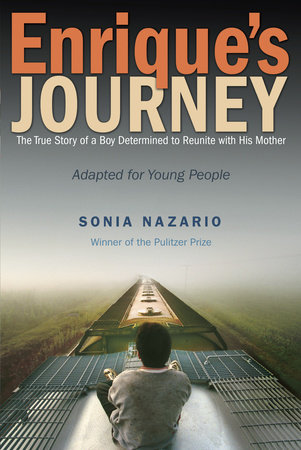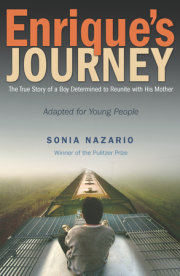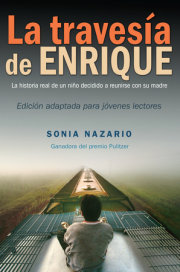Chapter 1The boy does not understand.
His mother is not talking to him. She will not even look at him. Enrique has no hint of what she is going to do.
Lourdes knows. She understands, as only a mother can, the terror she is about to inflict, the ache Enrique will feel, and finally the emptiness.
What will become of him? Already he will not let anyone else feed or bathe him. He loves her deeply, as only a son can. With Lourdes, he is openly affectionate. “
Dame pico, mami. Give me a kiss, Mom,” he pleads, over and over, pursing his lips. With Lourdes, he is a chatterbox. “
Mira, mami. Look, Mom,” he says softly, asking her questions about everything he sees. Without her, he is so shy it is crushing.
Slowly, she walks out onto the porch. Enrique clings to her pant leg. Beside her, he is tiny. Lourdes loves him so much she cannot bring herself to say a word. She cannot carry his picture. It would melt her resolve. She cannot hug him. He is five years old.
They live on the outskirts of Tegucigalpa, in Honduras. She can barely afford food for him and his sister, Belky, who is seven. She’s never been able to buy them a toy or a birthday cake. Lourdes, twenty-four, scrubs other people’s laundry in a muddy river. She goes door to door, selling tortillas, used clothes, and plantains.
She fills a wooden box with gum and crackers and cigarettes, and she finds a spot where she can squat on a dusty sidewalk next to the downtown Pizza Hut and sell the items to passersby. The sidewalk is Enrique’s playground.
They have a bleak future. He and Belky are not likely to finish grade school. Lourdes cannot afford uniforms or pencils. Her husband is gone. A good job is out of the question.
Lourdes knows of only one place that offers hope. As a seven-year-old child, delivering tortillas her mother made to
wealthy homes, she glimpsed this place on other people’s television screens. The flickering images were a far cry from Lourdes’ s childhood home: a two-room shack made of wooden slats, its flimsy tin roof weighted down with rocks, the only bathroom a clump of bushes outside. On television, she saw New York City’s spectacular skyline, Las Vegas’s shimmering lights, Disneyland’s magic castle.
Lourdes has decided: She will leave. She will go to the United States and make money and send it home. She will be gone for one year—less, with luck—or she will bring her children to be with her. It is for them she is leaving, she tells herself, but still she feels guilty.
She kneels and kisses Belky and hugs her tightly. Then she turns to her own sister. If she watches over Belky, she will get a set of gold fingernails from
el Norte.
But Lourdes cannot face Enrique. He will remember only one thing that she says to him: “Don’t forget to go to church this afternoon.”
It is January 29, 1989. His mother steps off the porch.
She walks away.
“¿Dónde está mi mami?” Enrique cries, over and over. “Where is my mom?”
His mother never returns, and that decides Enrique’s fate.
As a teenager—indeed, still a child—he will set out for the United States on his own to search for her. Virtually unnoticed, he will become one of an estimated 48,000 children who enter the United States from Central America and Mexico each year, illegally and without either of their parents. Roughly two thirds of them will make it past the U.S. Immigration and Naturalization Service.
Many go north seeking work. Others flee abusive families.
Most of the Central Americans go to reunite with a parent, say counselors at a detention center in Texas where the INS houses the largest number of the unaccompanied children it catches. Of those, the counselors say, 75 percent are looking for their mothers. Some children say they need to find out whether their mothers still love them. A priest at a Texas shelter says they often bring pictures of themselves in their mothers’ arms.
The journey is hard for the Mexicans but harder still for Enrique and the others from Central America. They must make an illegal and dangerous trek up the length of Mexico. Counselors and immigration lawyers say only half of them get help from smugglers. The rest travel alone. They are cold, hungry, and helpless. They are hunted like animals by corrupt police, bandits, and gang members deported from the United States. A University of Houston study found that most are robbed, beaten, or raped, usually several times. Some are killed.
They set out with little or no money. Thousands, shelter workers say, make their way through Mexico clinging to the sides and tops of freight trains. Since the 1990s, Mexico and the United States have tried to thwart them. To evade Mexican police and immigration authorities, the children jump onto and off of the moving train cars. Sometimes they fall, and the wheels tear them apart.
They navigate by word of mouth or by the arc of the sun. Often, they don’t know where or when they’ll get their next meal. Some go days without eating. If a train stops even briefly, they crouch by the tracks, cup their hands, and steal sips of water from shiny puddles tainted with diesel fuel. At night, they huddle together on the train cars or next to the tracks. They sleep in trees, in tall grass, or in beds made of leaves.
Some are very young. Mexican rail workers have encountered seven-year-olds on their way to find their mothers. A policeman discovered a nine-year-old boy near the downtown Los Angeles tracks. “I’m looking for my mother,” he said. The youngster had left Puerto Cortes in Honduras three months before. He had been guided only by his cunning and the single thing he knew about her: where she lived. He had asked everyone, “How do I get to San Francisco?”
Typically, the children are teenagers. Some were babies when their mothers left; they know them only by pictures sent home. Others, a bit older, struggle to hold on to memories: One has slept in her mother’ s bed; another has smelled her perfume, put on her deodorant, her clothes. One is old enough to remember his mother’s face, another her laugh, her favorite shade of lipstick, how her dress felt as she stood at the stove pattingtortillas.
Many, including Enrique, begin to idealize their mothers. They remember how their mothers fed and bathed them, how they walked them to kindergarten. In their absence, these mothers become larger than life. Although in the United States the women struggle to pay rent and eat, in the imaginations of their children back home they become deliverance itself, the answer to every problem. Finding them becomes the quest for the Holy Grail.
CONFUSION
Enrique is bewildered. Who will take care of him now that his mother is gone? Lourdes, unable to burden her family with both of her children, has split them up. Belky stayed with Lourdes’s mother and sisters. For two years, Enrique is entrusted to his father, Luis, from whom his mother has been separated for three years.
Enrique clings to his daddy, who dotes on him. A bricklayer, his father takes Enrique to work and lets him help mix mortar. They live with Enrique’ s grandmother. His father shares a bed with him and brings him apples and clothes. Every month, Enrique misses his mother less, but he does not forget her. “When is she coming for me?” he asks.
Lourdes and her smuggler cross Mexico on buses. Each afternoon, she closes her eyes. She imagines herself home at dusk, playing with Enrique under a eucalyptus tree in her mother’s front yard. Enrique straddles a broom, pretending it’s a donkey, trotting around the muddy yard. Each afternoon, she presses her eyes shut and tears fall. Each afternoon, she reminds herself that if she is weak, if she does not keep moving forward, her children will pay.
Lourdes crosses into the United States in one of the largest immigrant waves in the country’s history. She enters at night through a rat-infested Tijuana sewage tunnel and makes her way to Los Angeles. There, in the downtown Greyhound bus terminal, the smuggler tells Lourdes to wait while he runs a quick errand. He’ll be right back. The smuggler has been paid to take her all the way to Miami.
Three days pass. Lourdes musses her filthy hair, trying to blend in with the homeless and not get singled out by police. She prays to God to put someone before her, to show her the way. Whom can she reach out to for help? Starved, she starts walking. East of downtown, Lourdes spots a small factory. On the loading dock, under a gray tin roof, women sort red and green tomatoes. She begs for work. As she puts tomatoes into boxes, she hallucinates that she is slicing open a juicy one and sprinkling it with salt. The boss pays her $14 for two hours’ work. Lourdes’s brother has a friend in Los Angeles who helps Lourdes get a fake Social Security card and a job.
She moves in with a Beverly Hills couple to take care of their three-year-old daughter. Their spacious home has carpet on the floors and mahogany panels on the walls. Her employers are kind. They pay her $125 a week. She gets nights and weekends off. Maybe, Lourdes tells herself—if she stays long enough—they will help her become legal.
Copyright © 2006 by Sonia Nazario. All rights reserved. No part of this excerpt may be reproduced or reprinted without permission in writing from the publisher.











